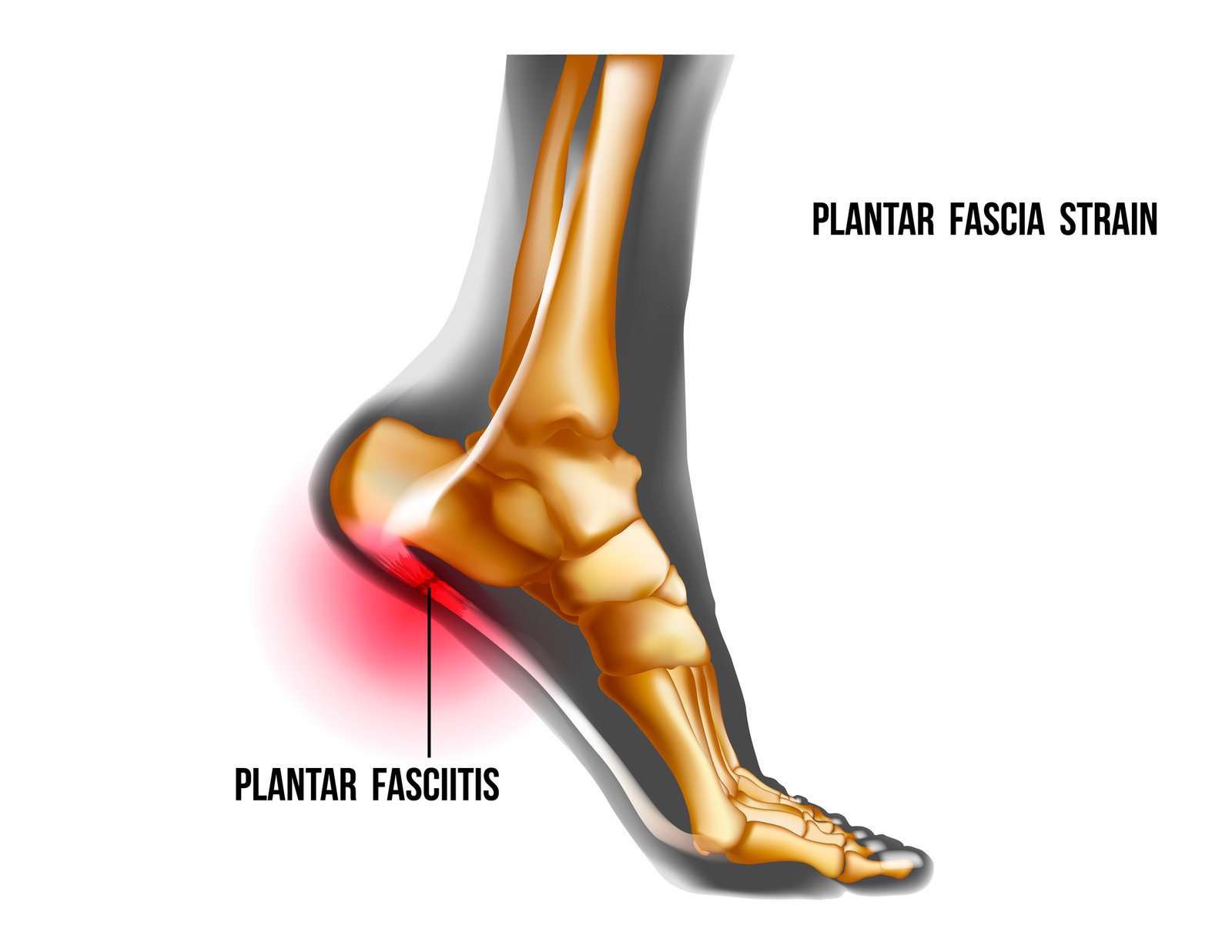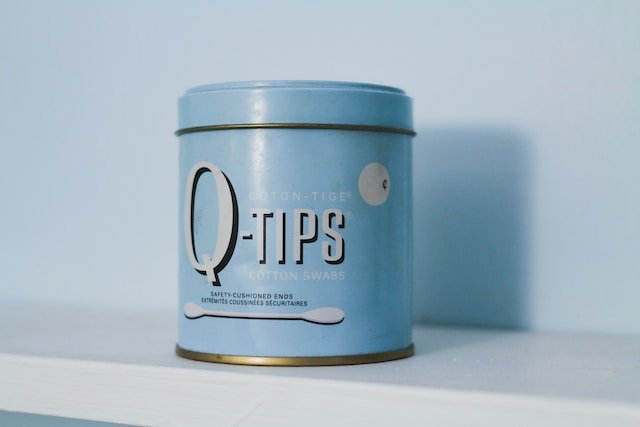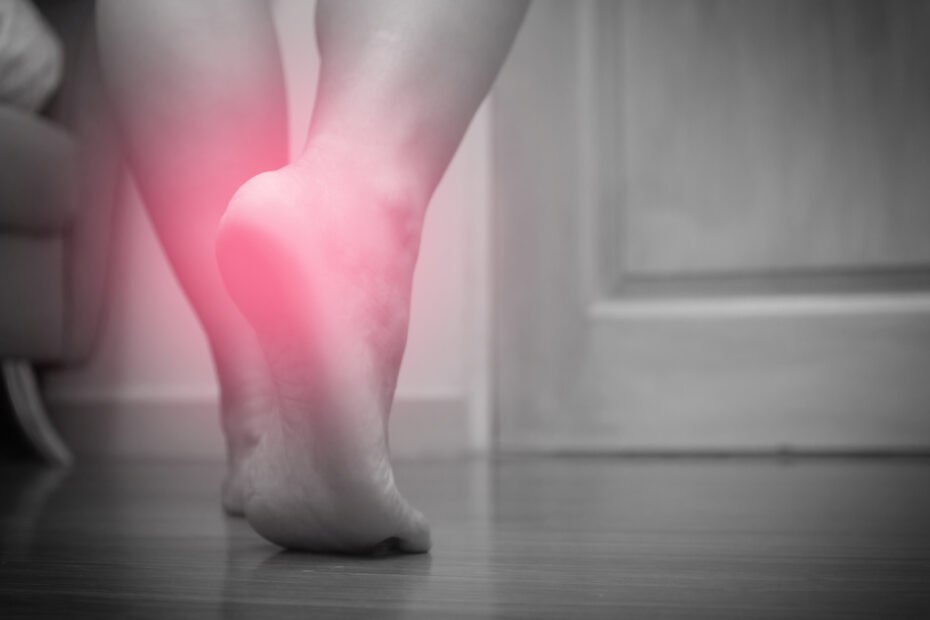In the quiet hours of the morning, before the world awakes, Sarah tiptoes across her bedroom, each step a measured attempt to avoid the sharp, stabbing pain that shoots through her heel. It’s a pain that’s become all too familiar in the past few months, ever since she entered menopause. Sarah, like many women in her stage of life, is battling menopause plantar fasciitis, a condition that seems to have intensified with the hormonal changes of menopause. This story, though unique to Sarah, echoes the experiences of countless women navigating the choppy waters of menopause and plantar fasciitis, searching for relief and understanding.
The Connection Between Menopause and Plantar Fasciitis
Menopause and plantar fasciitis share a link that goes beyond mere coincidence. Research suggests that the hormonal changes during menopause can lead to a decrease in collagen production, which affects the elasticity of the plantar fascia, the thick band of tissue that runs across the bottom of your foot. This can increase the risk of inflammation and pain associated with plantar fasciitis.
Furthermore, the weight gain often experienced during menopause can put additional pressure on the feet, exacerbating the condition.
The Role of Hormonal Changes in Foot Pain
While hormonal changes during menopause can lead to a variety of symptoms, including hot flashes and mood swings, the impact on feet is often overlooked. Understanding the role of hormonal changes in foot pain is crucial for menopausal women experiencing discomfort.
Hormones, such as estrogen, play a vital role in the body’s soft tissues, including the ligaments and tendons of the feet. Changes in estrogen levels can result in weakened ligaments and increased elasticity, potentially leading to foot conditions like plantar fasciitis.

Description of Hormonal Changes during Menopause
During menopause, the body goes through hormonal changes, particularly a decrease in estrogen (or oestrogen) levels. Estrogen is a hormone that plays a crucial role in the body, affecting everything from bone health to the elasticity of tissues.
As menopause approaches, estrogen levels decline, contributing to changes in the soft tissues of the feet. These changes can impact the arches of the feet, making them more prone to strain and injury.
Menopause-related hormonal changes can, therefore, directly influence foot health and the development of foot conditions, such as plantar fasciitis.
Connection between Hormonal Changes and Foot Pain
Hormonal changes during menopause, particularly the decrease in estrogen levels, can impact the production of collagen, a protein that provides strength and support to the body’s tissues, including tendons and ligaments.
Reduced collagen synthesis can affect the elasticity of tendons, making them less capable of withstanding everyday foot movements and activities. Consequently, menopause-related hormonal changes can lead to arch pain, can contribute to the development of foot conditions like plantar fasciitis.
Symptoms of Plantar Fasciitis in Menopausal Women
As menopause transition occurs, hormonal changes and the resulting impact on the feet can lead to specific symptoms of plantar fasciitis in menopausal women. Identifying these symptoms is crucial for timely intervention and pain management.
Menopausal women with plantar fasciitis may experience heel pain and tenderness, particularly with the first steps of the day. Aches in the bottom of the foot, near the heel, may also be a common symptom. It’s important to note that menopause-related changes, such as weight gain or changes in foot structure, can exacerbate the discomfort of plantar fasciitis.

Specific Symptoms in Menopausal Women
In addition to the general symptoms, menopausal women may experience specific symptoms related to plantar fasciitis. Weight gain associated with menopause can put additional pressure on the feet, exacerbating the discomfort of plantar fasciitis.
Changes in foot structure, such as developing high arches or having flat feet, can also increase the risk of plantar fasciitis. Menopause-related changes may lead to a predisposition for soft tissue injury, making the feet more vulnerable to conditions like plantar fasciitis.
How to Manage Plantar Fasciitis during Menopause
While plantar fasciitis can be a challenging foot condition, there are strategies menopausal women can employ to manage the discomfort. Adopting the proper footwear, implementing proactive foot care tips, and engaging in beneficial exercises are essential for plantar fasciitis management during menopause transition.
By incorporating these strategies into your daily routine, you can find relief from plantar fasciitis pain and maintain foot health.
Importance of Proper Footwear
Choosing the right footwear is crucial in managing plantar fasciitis pain during menopause. Opt for supportive shoes that provide adequate arch support, heel cushioning, and shock absorption. Avoid high heels and shoes with little to no arch support, as these can exacerbate the discomfort of plantar fasciitis.
Orthotics, foot inserts, or arch supports recommended by a podiatrist can also provide additional support and help relieve plantar fasciitis pain. Wearing the proper footwear can significantly decrease the strain on the plantar ligament, reducing the risk of injury and inflammation.

Proactive Foot Care Tips
In addition to choosing supportive footwear, menopausal women with plantar fasciitis can take a proactive approach to foot care. Consider incorporating the following tips into your daily routine:
- Maintain a healthy weight: Excess weight puts additional stress on the feet, worsening plantar fasciitis pain.
- Make lifestyle changes: Avoid long periods of standing or intense activity that may worsen foot discomfort.
- Stay hydrated: Drinking plenty of water helps maintain the elasticity of tendons, supporting foot health.
- By adopting these foot care tips, menopausal women can alleviate plantar fasciitis pain and promote overall foot health.
Beneficial Exercises for Foot Health
Engaging in beneficial exercises can play a significant role in managing plantar fasciitis pain during menopause transition. Consider incorporating the following exercises into your routine:
- Gentle foot stretches: Calf stretches, toe curls, and toe flexes can help relieve tension in the plantar fascia.
- Aerobic exercises: Low-impact activities like walking or swimming can support foot health.
- Wear athletic shoes: Invest in athletic shoes specifically designed for plantar fasciitis, as they offer extra cushioning and arch support.
- Physical therapy: Consult a physiotherapist for a personalized exercise program targeting plantar fasciitis relief.
- Use orthotics: Podiatrist-recommended orthotics can provide additional support and alleviate plantar fasciitis discomfort.
- By incorporating these exercises and strategies, menopausal women can improve foot health, reduce inflammation, and manage the symptoms of plantar fasciitis.

How theheelgp.com Can Assist
For those navigating the complexities of plantar fasciitis during menopause, theheelgp.com offers a beacon of hope. With comprehensive reviews of treatment options and a wealth of resources, the site empowers sufferers to make informed decisions about their care. Whether you’re exploring home remedies or considering professional treatments, we provide guidance and support tailored to your unique journey towards relief.
Conversations with a Physician about Plantar Fasciitis
Navigating the discomfort of plantar fasciitis during menopause can be challenging, but seeking professional guidance is essential. Knowing when to consult a physician and how to prepare for the visit can help menopausal women get the care they need.
When to Consult a Physician
If the pain associated with plantar fasciitis persists or worsens, it’s time to consult a healthcare professional. Consider reaching out to a podiatrist or physiotherapist if you experience ongoing discomfort, joint pain, or difficulty performing your regular activities. Seeking professional care can ensure proper diagnosis and the implementation of effective treatment strategies for plantar fasciitis.
Preparing for the Physician’s Visit
Before your visit, it’s important to gather as much information as possible to help your physician assess your condition. Prepare for the visit by documenting your symptoms, including the duration and intensity of foot pain.
Provide a detailed medical history, including any previous foot injuries or conditions. Bring the footwear you wear regularly, as your podiatrist may want to evaluate their impact on your feet. Lastly, a gait analysis may be conducted to assess your walking pattern and foot mechanics.

Real Life Experiences: Stories from Menopausal Women
Hearing the experiences of menopausal women who have dealt with plantar fasciitis can provide insight and support for others going through a similar journey. Let’s explore a story that highlight the challenges and triumphs of managing foot pain during menopause.
Real Life Story: Overcoming Foot Pain during Menopause
One midlife woman, Linda, experienced severe foot pain during menopause due to plantar fasciitis. Seeking relief, she consulted a physiotherapist who recommended lifestyle changes such as weight management and regular physiotherapy exercises to alleviate discomfort.
Linda also transitioned to supportive footwear and orthotics, which provided the necessary arch support and cushioning to reduce plantar fasciitis pain. With the guidance of her healthcare professionals, Linda was able to overcome foot pain and maintain an active lifestyle during menopause.
How does Menopause affect your daily life activities?
Menopause, including the discomfort of plantar fasciitis, can take a toll on daily activities for menopausal women. Simple tasks like walking, exercising, or even standing for long periods of time can become a challenge.
Menopause-related hormonal changes, combined with the discomfort of plantar fasciitis, can limit mobility and make body weight management more difficult.
Understanding the impact of menopause on foot health is crucial, as it allows menopausal women to be proactive in implementing foot care measures and lifestyle changes that support pain management and a higher quality of life.

Is plantar fasciitis common in menopause?
Yes, plantar fasciitis can be more common in menopause due to hormonal changes, changes in foot structure, and weight gain associated with menopause. It’s essential to take proactive measures, such as wearing supportive footwear and engaging in foot exercises, to manage plantar fasciitis pain during menopause transition. Consulting a healthcare professional can provide personalized treatment options and support.
Can menopause cause bottom of feet to hurt?
Yes, menopause-related hormonal changes can cause foot pain, including plantar fasciitis, which can affect the bottom of the foot. Decreased estrogen levels during menopause transition can reduce collagen production, making the feet more susceptible to injury and inflammation. Maintaining a healthy weight, wearing supportive shoes, and seeking professional care can help alleviate foot pain during menopause.
Are there any natural remedies for plantar fasciitis that are safe for women going through menopause?
Yes, there are several natural remedies for plantar fasciitis that are safe and can be particularly beneficial for women going through menopause. These remedies focus on reducing inflammation, improving foot mechanics, and enhancing overall foot health without the need for pharmaceutical interventions. Here are some effective natural strategies:
- Stretching and Strengthening Exercises: Regularly performing stretches for the Achilles tendon and the plantar fascia can relieve tension and pain. Strengthening exercises for the lower leg and foot muscles can also help stabilize your ankle and improve foot mechanics.
- Cold Therapy: Applying an ice pack to the affected area for 15-20 minutes several times a day can help reduce inflammation and relieve pain. This is a simple, effective treatment that can be easily incorporated into your daily routine.
- Massage: Massaging the bottom of your foot with a ball (like a tennis ball or a specialized massage ball) can help loosen up the plantar fascia, improving flexibility and decreasing pain. This technique can be particularly soothing and beneficial before taking your first steps in the morning.
- Anti-inflammatory Diet: Adopting an anti-inflammatory diet rich in fruits, vegetables, nuts, seeds, and omega-3 fatty acids can help reduce overall inflammation in the body, potentially alleviating symptoms of plantar fasciitis. This approach not only benefits your feet but can also support overall health during menopause.
- Weight Management: Maintaining a healthy weight can significantly reduce the pressure on your feet and decrease the strain on the plantar fascia. This is especially important during menopause, as hormonal changes can make weight management more challenging.
- Proper Footwear: Choosing shoes with adequate arch support and cushioning can prevent further strain on the plantar fascia. Avoiding high heels and opting for supportive, comfortable shoes can make a significant difference in managing pain and preventing further damage.
- Herbal Remedies: Some women find relief using herbal supplements with anti-inflammatory properties, such as turmeric, ginger, and omega-3 fatty acids. However, it’s important to consult with a healthcare professional before starting any new supplement, especially during menopause, to ensure it doesn’t interfere with other aspects of your health care.
- Adequate Rest: Ensuring that you rest your feet and avoid activities that exacerbate your symptoms can help the healing process. It’s important to listen to your body and give it the time it needs to recover.
While these natural remedies can be effective for many women, it’s essential to remember that individual responses can vary. If your symptoms persist or worsen, consulting with a healthcare provider is advisable to ensure a comprehensive treatment plan that addresses your specific needs.

Conclusion
Menopause and plantar fasciitis, intertwined through the intricacies of the female body, present a challenge that demands attention and care. By understanding the connection and adopting a holistic approach to treatment, women can navigate this phase with confidence and comfort.
The journey towards healing is personal and varied, but with the right resources and support, relief is within reach. Have you considered how your current lifestyle might be impacting your plantar fasciitis?
I hope you found this blog helpful and please feel free to comment and share.
Thanks for reading!
 | Tracy J. Founder, The heel GP |
